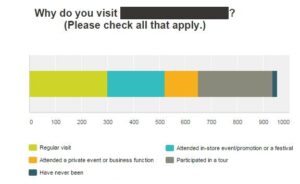Easy Research with Online Surveys
I spent three days last month kicking off a research study for our client, the Finger Lakes Regional Tourism Council. The purpose of the study is to increase visitation to the 14 county Finger Lakes Vacation Region through an in-depth destination market analysis and companion strategic marketing plan. We met with stakeholders throughout the Finger Lakes Region representing, wineries, wine trails, breweries, hotels, large museums, small volunteer museums, restaurants and more. I was struck by the level of interest that each stakeholder has in this project. The consulting team that we are working with from Strategic Advisory Group asked each stakeholder to share how they make marketing decisions and to share any research that they use. I was impressed by the number of stakeholders that use some form of research when making their marketing decisions. Some use Google Analytics, others use Facebook Insights, others rely on research by third parties and so on. One of the participants talked about using TripAdvisor reviews. They not only look at the reviews of their own attraction but then they read other reviews by the same user to try and piece together a pattern of the user’s experience.
All of this talk about research reminded me of an article that I had written on how small businesses can learn from their customers, which will help them make better marketing decisions. I decided to dust off the old article and share it again here.
Want to know how to grow your business? Ask your customers.
Many small businesses think customer research is an expensive endeavor that is out of their reach. In today’s digital world, it is simpler than ever to conduct your own research study. Using online survey tools such as Survey Monkey, small businesses can create a survey that will assist them in making key business decisions. By tapping their current customers, business owners will gain valuable insight that can help identify growth markets, pinpoint new product offerings and make advertising decisions easier.
Email, Facebook and other social media channels provide ready access to customers. Businesses should use all communication channels when launching a survey. The basic concept is: find out what your current customers like, how they perceive you and where they heard about you, then use that information to find more customers just like them.
When surveying customers consider framing questions in these areas:
Brand Awareness: How did the customer first make a decision to come to your business? Where did they first hear about you? This will help you determine an acquisition strategy. Brand Perception: How does the customer perceive your business? What do they like most? This helps determine a message based on what is important to the customer.
Brand Perception: How does the customer perceive your business? What do they like most? This helps determine a message based on what is important to the customer.
Frequency of Visits: How often does this particular customer visit your business? What competitors do they visit for the same or similar service? Results of the survey can be weighted to identify more frequent visitors and thus target customer acquisition efforts towards those who will spend more.

Media Usage: Which media does the audience engage in, to what extent, and which are preferred? This will provide insight into traditional and social media usage and can help identify the best place to spend advertising dollars.


Demographics: Age, income levels, gender and geographic area all play an important role in the information gathering process. This data can be the most revealing for new markets. For example, you may find that the majority of your customers are over the age of 55. Depending on your product or service, there may be an opportunity to target a younger consumer and expand your business.


Most online survey tools offer helpful widgets that will assist with drafting questions. A good tool will provide a portal to collect customer responses and easy-to-read data summaries for your analysis. To ensure a good response, offer your customers an incentive such as a chance to win a gift certificate for your business just by filling out the survey. Keep your surveys short, 20 questions maximum, and they should take less than 10 minutes to complete. Let your customers know that you appreciate their business and value their input, most people will be happy that you asked.

Related Posts
10 Must-Listen Podcasts for Travel, Tourism & Hospitality Professionals
I’ve had the joy of hosting Destination on the Left—an award-winning podcast spotlighting the travel, tourism, and hospitality industry—since 2016. My team and I believe…
How Tourism Brand Ambassadors Elevate Your Destination Story
In today’s world, it can seem like everything in marketing and sales has changed. But the one thing that hasn’t changed is the value of...

